|
|
|
|
Products mentioned in this Article
--None--
|
|
|
|
|
|
|
|
|
 |
|
|
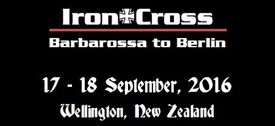 |
Iron Cross: Barbarossa to Berlin
Part Two
with Tony Bates
In part one of my report, I covered off the genesis of my multi-period themed competition. In this second and final part, I’ll cover off some of the competition specific factors that I think made Iron Cross: Barbarossa to Berlin stand out.
|
Since the competition was a team event and there was an auto attack/defence rule in place for all players’, mission selection was crucial so that no one player was disadvantaged. A lot of thinking went into selecting the battles of the Eastern Front campaign that I wanted to highlight through the competition and rather than relying on a random draw, I opted to select the missions that I thought would best represent those moments in the campaign.
Right: Professionally branded tape measures were the inaugural Iron Cross free gift. |
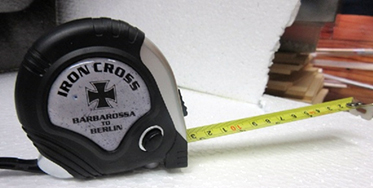 |
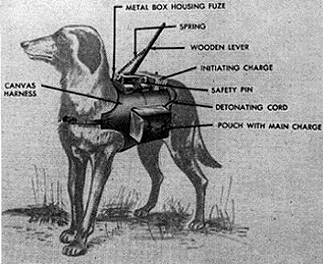 |
Mission selection was only one part, however. To really bring the special character of the battles that I had chosen to the fore, I opted to introduce some special rules.
For example, in the first mission, each Russian player had six War Dog tokens. This was to reflect the Russian programme of training dogs to crawl under tanks. I attached the image on the left to a small base (yep, I did sixty of them). It was amusing to hear the various calls of “Woof woof” and “Who let the dogs out!” as the Russian players deployed their dogs.
Left: The much vaunted "War Dog".
|
In the second mission, all tables were deemed to be covered in deep snow to reflect the extremely bitter winter of 1941-42 with its minus 40-degree temperatures, which made the whole table Slow Going. The German players were also hampered with having their forces exhausted, which meant they couldn’t double (troublesome when half your army is in Delayed Reserves!)
One of the other significant rules I introduced was the full rubble effects inside the Cauldron, during the mission of the same name. Since the mission was effectively being fought in the ruined landscape of Stalingrad, I figured rubble should play an important role. With the help of Photoshop plus several hours of cutting and taping, I created a rubble boundary effect (you can see the strip in the image to the right. Unsurprisingly, the various Russian tank companies were reluctant to attack into the Cauldron!
|
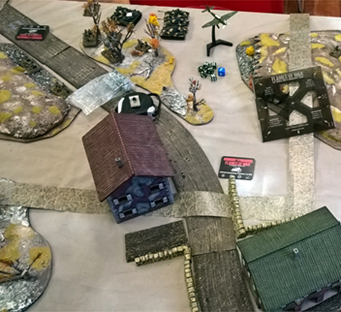 |
| There were also rules on preparatory bombardments, snow storms, booby traps, and extra heavy field defences during our Kursk battle. Each of these rules introduced a new element to an otherwise predictable mission format and challenged players to either take advantage of them or think hard on how to negate them. These additions are examples of how with a little imagination anybody can turn the generic Flames Of War missions into bespoke encounters. As I mentioned in the previous part this was an excellent way of introducing story elements. The best part was seeing the posturing from the players as they anticipated the next mission and how historically ‘their’ side had the upper hand. |
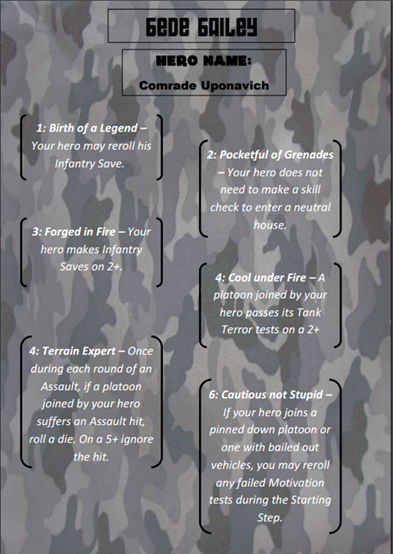 |
Another new element that I introduced was the concept of a Free Hero. As an old-school gamer, I’m a fan of having a sense of progression in the games that I play. I thought it would be cool if each army had a stand-out hero that became more skilled and lethal as the campaign progressed (in the same vein of Infantry Aces). Combing through all of Battlefront’s Intelligence Briefings I put together a list of all the special skills that various heroes have. Adding in a few of my own I then created a bespoke hero for each player where after each battle they survived they developed a new skill. Each player was provided with a card similar to the one below (players were required to provide a two-figure infantry stand to represent their hero – some of the modelling efforts were absolutely first rate as players really got into the idea!) There was also a medal up for grabs for the player whose hero achieved the highest number of kills across the competition.
Something else that I wanted to experiment with was how each game was scored. I’ve never been a fan of scoring systems which seek to have a zero sum outcome. If players are successful they should be rewarded, but not at the expense of their opponent. Army mismatches often result in the stronger player earning the lion’s share of the points even though they had to do very little to earn them. Whereas two equal armies who fight tooth and nail for the win end up only a point apart.
Left: Bede Bailey's Free Hero.
|
I wanted the scoring system to reflect the amount of effort required to achieve the win. So after playing around with some different scoring ideas, I settled on using a platoon’s points value as the scoring mechanism. If a platoon is destroyed, the destroying player earns the platoon’s value in victory points. If an army is broken (but not necessarily destroyed) then the successful commander earns the full value of their opponent’s list (excluded aircraft options). Adding in 1000 points the win meant that the winner would come away with a nice little total.
The benefit from this approach was that both players could rack up points without having their opponent’s successes detract from theirs. Below are the round-by-round results of the first day’s games. On Saturday night I emailed out the day’s results and a comment I got back from the competition’s eventual winner (who had racked up over 5000 points on day one) articulated exactly what I was trying to achieve with the different scoring system.
“Five thousand points? Sheesh, makes it sound like I’ve been doing something.”
~ Bede Bailey.
|
| Name |
Round One |
Name |
Round Two |
Name |
Round Three |
| Mark |
2045 |
Warren |
2160 |
Sofia |
2500 |
| Andrew O |
1895 |
Andrew S |
1740 |
Ken |
2380 |
| Bede |
1740 |
Russell |
1650 |
Bede |
2325 |
| Ken |
1645 |
Bede |
1595 |
Simon |
2285 |
| Simon |
1625 |
Paul |
1580 |
Damien |
2030 |
| Warren |
1480 |
Cameron |
1505 |
Russell |
1820 |
| Paul |
1345 |
Gavin |
1455 |
Graham |
1725 |
| Gavin |
1305 |
Mark |
1255 |
Bob |
1575 |
| Russell |
1155 |
Joseph |
1235 |
Joseph |
1455 |
| Cameron |
1060 |
Bob |
1000 |
Paul |
1450 |
| Andrew S |
445 |
David |
735 |
John F |
735 |
| John L |
320 |
Andrew O |
440 |
David |
720 |
| David |
300 |
Graham |
385 |
Andrew S |
715 |
| Sofia |
295 |
John F |
305 |
Gavin |
550 |
| John F |
155 |
Damien |
270 |
Andrew O |
280 |
| Joseph |
0 |
Bryan |
195 |
Mark |
125 |
| Graham |
0 |
Simon |
145 |
Warren |
0 |
| Damiem |
0 |
Sofia |
115 |
Cameron |
0 |
| Bob |
0 |
Ken |
0 |
Bryan |
0 |
| Bryan |
0 |
John L |
0 |
John L |
0 |
| German players names are in Blue. |
Soviet players names are in Red. |
|
|
The team element and having the players choose their opponents and their table meant that mismatches were virtually eliminated. The entire team wanted everyone to have a fighting chance and the ability to generate the most victory points for the team.
The final results are at the end of this article for those that are interested. So with the games concluded and the results tallied, to the victor the spoils right?
As I mentioned in the first report, I had always envisioned the medals for the competition being of an Iron Cross design. After some months of searching, a local trophy manufacturing company was able to assist. The result (below) is stunning in my humble opinion.
|
|
There were medals for each member of the winning team as well as the individual medals for the top three players and best sport and of course one for the player who had the best performing hero.
Russell Briant, a member of the winning Team Soviet who also got the second best individual score and had the best performing hero, was walking around with three medals clinking around his neck. He reminded me a little of the medal-bedecked Russian generals at May Day parades!
Lastly, wanting my comp to be a complete experience, I offered to arrange themed catering. For a small cost, players were able to enjoy a contemporary twist on traditional fare for their side. It was the pièce de résistance of the competition to see a player manoeuvring their Panzer IVs across the table while chowing down on a Veal Schnitzel & Chive Sour Cream on Dark Rye and washing it down with a beer. The Soviet comrades were treated to some Russian favourites and a little bit of vodka to wash it all down. Not only did the players enjoy a great weekend of gaming, but their taste buds had a fantastic time as well.
|
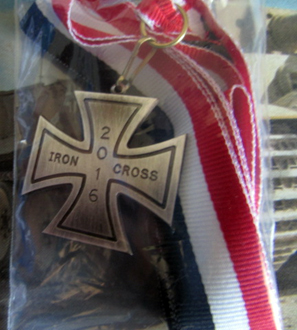 |
So in conclusion, my first comp was very successful. While it did take a lot of organising, a competition is nothing without its players. I can only thank my 20 players who attended, who all approached my comp with open minds and a willingness to try new things. They all played hard but fair and excuse the cliché, but gaming really was the winner on the day.
~ Tony. |
| Below: The victorious Soviet players. |
Below: Team Wehrmacht and friends. |
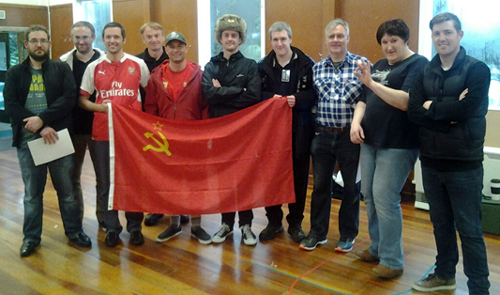 |
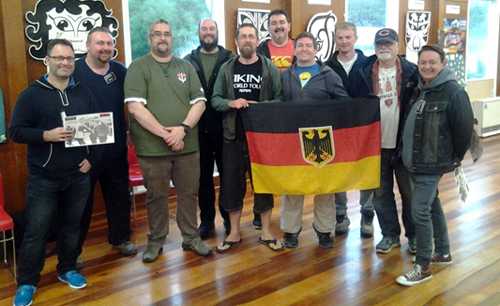 |
| Final Results |
| Rank |
Name |
Total Points |
Army Type |
| 1. |
Bede Bailey |
10275 |
Russian Strelkovy |
| 2. |
Russell Briant |
8550 |
Russian Cossacks |
| 3. |
Paul Waechter |
8390 |
German Panzers |
| 4. |
Sofia Chambers |
8310 |
Russian Tankovy |
| 5. |
Joseph Kelly |
8020 |
Russian Tankovy |
| 6. |
Ken Camel |
7915 |
German Pioneers |
| 7. |
Cameron Wansbrough |
7660 |
Russian Tankovy |
| 8. |
Warren Hart |
7285 |
German Grenadiers |
| 9. |
Mark Stanton |
6470 |
Russian Tankovy |
| 10. |
Andrew Stanton |
5670 |
German Grenadiers |
| 11. |
Simon McBeth |
5555 |
German Panzergrenadiers |
| 12. |
Graham Henderson |
5515 |
German Panzers |
| 13. |
Damien Tyson |
5415 |
Finnish Infantry |
| 14. |
Bob Pearce |
5125 |
Russian Tankovy |
| 15. |
Gavin van Rossum |
4940 |
Russian Tankovy |
| 16. |
John Fletcher |
4470 |
Russian Tankovy |
| 17. |
Andrew Olds |
4115 |
Russian Cossacks |
| 18. |
Bryan Thomson |
3370 |
German Grenadiers |
| 19. |
John Lee |
3305 |
German Panzers |
| 20. |
David Wilson |
2010 |
Hungarian Armour |
| German players names are in Blue. |
Soviet players names are in Red. |
|
Last Updated On Wednesday, January 25, 2017 by Blake at Battlefront
|
|
|